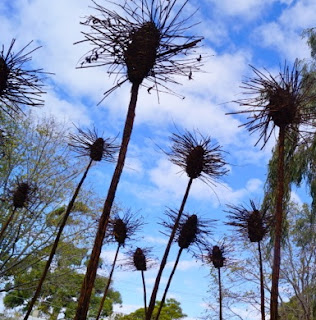BRIGIT HELLER WINDOWSPACE-BEEAC 4
June 11 – 12 July 2015
Swiss-born Brigit Heller’s route to sculpture
was one she has described as the ‘discovery of a new and fascinating world,
which I am still exploring, experiencing and diving into every day’. Heller’s
adventurous spirit is stimulated by her environment, urban and natural – she
works in the city and lives in Central Victoria, and so has access to a wide range of
stimuli.
Her most recent work, Off
the Ground, (image below), formed part of a one-day event at Gasworks,
South Melbourne, April 2015. The show, From Nature, responded to the brief to create organic ‘living’ public
art using natural found materials, in much the same way indigenous peoples
reach for what is around them to create what they need and enjoy.
Off the Ground - 2015
Heller finds that: ‘in the
landscape I experience a much bigger sense of freedom and generosity … I can
explore shapes, and forms of material, as objects are wrapped, reassembled or
altered … works are usually created in a very spontaneous way. I go to a place
and become inspired by what is there. I use natural materials or ready-made
objects which I place in the landscape.’
Heller’s work is not without humour
and wit. She observes:
‘It is my intention for the changes in
objects to be aesthetically subtle, poetic and in some instances to be entering
the realm of the ridiculous. Whilst still recognizable, functionality in all
instances has seriously been tampered with.’
Her work has been influenced by an
appreciation of the work of:
‘Andy Goldsworthy, David Nash, Richard
Long, Bob Verschueren and Niels Udo. Artists that create within a landscape not
necessarily requiring a gallery space, with minimal interference and in tune
with nature.’
Her childhood in Switzerland of
course also had its influence:
‘Processes
that I apply within my works have roots dating back to my childhood. Due to a
physical disability, my maternal grandfather earned a living as a basket
weaver. Even back then, this was considered a dying profession and a skill he
was keen to pass on. As a result, as children we spent some of our holidays
weaving baskets.
My approach to material and
craftsmanship has links to the fibre art movement that has emerged during the
early 1950’s, particularly in America under the influence of the artist Ed
Rossbach. One of his pupils was Gyoengy Laky, an artist whose work is composed
of orchard debris, park trimmings and prunings, a renewable, freely available
resource. Her work is as much about changing attitudes of people within a
consumer society as fostering a relationship between people and nature.’
In an essay on Heller’s work, Ken
Scarlett, senior authority on Australian sculpture, writes:
‘I distinctly remember being very
impressed when I first saw her work in an outdoor exhibition at Mt Macedon in
1998 … A time of healing, it
consisted of a simple cairn of burnt branches and twigs, cut at one end and
stacked to form a slightly irregular cone. Nearby was another heap of burnt and
blackened logs of wood. A reminder of the recent bush fires, it was both a
simple memorial and a thought provoking sculptural arrangement. Using local
materials, the newcomer from Europe had made a telling statement about this
Australian environment.’
…
Scarlett also refers to a later
work, Flying Blind, 2000, which consisted
of:
‘five towering cylinders of woven
willow branches, 2.4 meters high … Unexpectedly narrow at the base, the forms
appeared to spiral upwards, imbuing the works with a sense of vitality and
movement. While realising that they were made by hand, they had also a feeling
of organic growth as they emerged, plant-like from the soil.’
...
(Scarlett observes that with) ‘Poles Apart, shown as part of the McClelland Survey and Award in 2003, she (Heller) switched
from willow to wire to weave six gigantic flower-like forms set on high steel
poles. These forms of nature now emerge from the lawn outside the Icon Museum
of Art (Deakin University) making a great contrast to the urban environment,
giving people something else to experience.’
Brigit Heller’s practice is both
vigorous and subtle. Her work is always responsive to an underlying curiosity, sensitivity
and intelligence, the armature of her innate appreciation of primal
environmental forces, and as such it forms a body of sensibilities of which
we should all take note – before it is too late.
Recipient of art prizes including Lorne Sculpture prizes in 2009
(Regional Artists Prize) and 2011 (Mars Gallery Prize), and the The Helen
Lempriere National Sculpture Award, Popular Choice Award of 2001, Heller’s work
has been commissioned and is held in the collection of various authorities,
including the Cities of Bendigo and Ballarat, Deakin University, Parks and
Wildlife Tasmania, and Parks Victoria.




